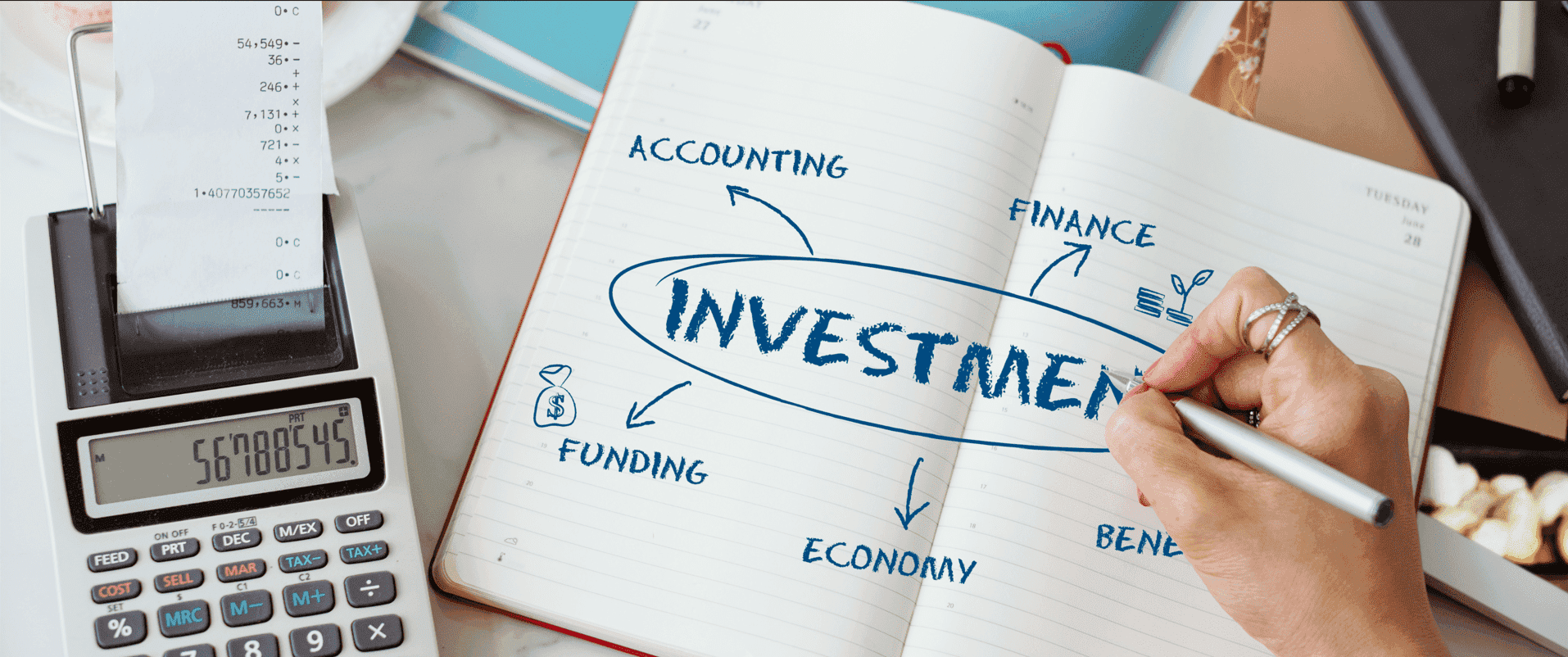- Investing For Beginners: What Is Investing? How Does Investing Work?
- The BROKSTOCK promise
- Key Takeaways
- How to Invest in Stocks: A Beginner's Guide
- A Brief History of Investing
- Example of Returns From Investing
- How Does Investing Work?
- Investing - The sooner the better
- Two Words — Compound Interest
- Investment amount is the key
- Choose an investment strategy
- Open an investment account
- Understand your investment options available
- The Basic Types of Investment Option Available to you
- Alternative Investments
- State of an Economy and Assets
- Different Asset Classes Available
- Asset Liquidity
- Assets in Case of High Inflation
- Most Popular Investing Styles
- The Risks of Investing and How To Deal With Them
- Risk and Diversification
- The Bottom Line
Investing for Beginners: All You Need To Know

Investing For Beginners: What Is Investing? How Does Investing Work?
Investing is a time-tested way of putting your money to work for you, as you work to earn more of it. Legendary investor Warren Buffett defined it as "forgoing consumption now in order to have the ability to consume more at a later date."
We can characterize it as a process of buying assets such as shares, unit trusts, or property with the expectation that you will make profit. Investments usually achieve long-term goals, they can make your funds work for you, and help you to create and preserve wealth.
How does it work? It works if you put your money in an account or fund with the goal of making a profit. Investing comes with the potential of greater rewards (which can include more risk) over time. That's why some people use investments to reach long-term goals such as retirement.
The BROKSTOCK promise
Our aim is to help you make smarter financial decisions. We do this by complying with strict editorial integrity. This article may contain references to products fr om our affiliates. The information does not constitute advice of any nature whatsoever, and should not be relied upon in any way, including making any decision.
Key Takeaways
- Your investing journey starts with a plan and a time frame; when you know how long you're investing for and what you hope to gain, you can put the structure in place to achieve it.
- Next, learn about how the market works, figure out which strategy is best for you, and determine what kind of investor you are.
- Diversify your portfolio.
- Be careful who you take advice fr om and be mindful of your own prejudices and assumptions, while you find the right path for you.
- Make sure you understand this is a long-term journey so that you won't get tripped up by short-term setbacks – always stay open and learn fr om your mistakes.
How to Invest in Stocks: A Beginner's Guide
1. Decide how you want to invest in the stock market
There are several ways to approach stock investing as a beginner. Choose the option below that best represents your approach:
A. "I'd like to choose on my own investments."
B. "I'd like an expert to manage the process for me."
C. “I'd like to start investing in my employer's pension fund."
In many ways, it teaches newbies some of the most proven methods: making small contributions on a regular basis, focusing on the long-term, and taking a hands-off approach.
2. Choose an investing account
Once you have a preference in mind, you're ready to shop for an account. For the hands-on types, this usually means a brokerage account. For those who would like a little help, opening an account through a robo-advisor is a sensible option. We break down both processes below.
An important point: Both brokers and robo-advisors allow you to open an account with very little capital.
The DIY option: opening a brokerage account
An online brokerage account likely offers your quickest and least expensive path to buying stocks, funds, and a variety of other investments. With a broker, you can open an individual retirement account, also known as an IRA, or you can open a taxable brokerage account if you're already saving adequately for retirement in an employer pension plan or other plan.
We have a guide to opening a brokerage account if you need a deep dive. You'll want to evaluate brokers based on factors such as costs, investment selection and investor research and tools.
The passive option: opening a robo-advisor account
A robo-advisor offers the benefits of stock investing, but doesn't require its owner to do the legwork required to pick individual investments. Robo-advisor services provide complete management: These companies will ask you about your financial goals during the onboarding process and then build you a portfolio designed to achieve those aims.
This may sound expensive, but the management fees here are generally a fraction of the cost of what a human investment manager would charge: Most robo-advisors charge about 0.25% of your account balance. And yes — you can also get an IRA through a robo-advisor if you wish.
If you choose to open an account at a robo-advisor, you probably don't need to read on — the following is mainly aimed at those DIY types.
3. Learn the difference between investing in stocks and funds
Going the DIY route? Don't worry. For most people, stock market investing means choosing among these two types:
Stock mutual funds or exchange-traded funds. Mutual funds let you purchase small pieces of many different stocks in a single transaction. Index funds and ETFs are a kind of mutual fund that tracks an index; for example, a S&P 500 fund replicates that index by buying the stock of the companies in it.
When you invest in a fund, you also own small pieces of each of those companies. You can put several funds together to build a diversified portfolio. Note that stock mutual funds are also sometimes called equity mutual funds.
Individual stocks. If you're after a specific company, you can buy a single share or a few shares as a way to dip your toe into the stock-trading waters. Building a diversified portfolio out of many individual shares is possible, but it takes a significant investment and research.
If you go this route, remember that there will be ups and downs. If you research a company and choose to invest in it, think about why you picked that company in the first place if jitters start to set in on a down day.
The upside of stock mutual funds is that they are inherently diversified, which lessens your risk. For the vast majority of investors — particularly those who are investing their retirement savings — a portfolio made up of mostly mutual funds is the clear choice.
But mutual funds are unlikely to rise in meteoric fashion as some individual stocks might. The upside of them is that a wise pick can pay off handsomely, but the odds that any individual stock will make you rich are exceedingly slim.
4. Set a budget for your stock market investment
New investors often have couple questions in this step of the process:
How much do I need to start investing in stocks? What are good investments for beginners? The amount of funds you need to buy an individual stock depends on how expensive the shares are. (Share prices can range fr om just a few rands to a few thousand rand.)
If you want mutual funds and have a small budget, an exchange-traded fund (ETF) may be your best bet. Mutual funds often have minimums of R10,000 or more, but ETFs trade like a stock, which means you purchase them for the share price — in some cases, less than R1,000).
How much money should I invest in stocks? If you're investing through funds — have we mentioned this is the preference of most financial advisors? — you can allocate a fairly large portion of your portfolio towards stock funds, especially if you have a long time investment horizon.
A 30-year-old investing for retirement might have 80% of their portfolio in stock funds; the rest would be in bond funds. Individual stocks are another story. A general rule of thumb is to keep these to a small portion of your portfolio.
5. Focus on investing for the long-term
The stock market has proven to be one of the best ways to grow long-term wealth. Over several decades, the average stock market return is about 10% per year. However, remember that's just an average across the entire market — some years will be up, some down and individual shares will vary in their returns.
For long-term investors, the stock market is good no matter what's happening day-to-day or year-to-year; it's that long-term average they're looking for.
The best thing to do after you start investing in stocks or mutual funds may be the hardest: Don't look at them! Unless you're trying to beat the odds and succeed at day trading, it's good to avoid the habit of compulsively checking how your stocks are doing several times a day, every day.
6. Manage your stock portfolio
While fretting over daily fluctuations won't do much for your portfolio's health — or your own — there will of course be times when you'll need to check in on these or other investments.
If you follow the steps above to buy mutual funds and individual stocks over time, you'll want to revisit your portfolio a few times a year to make sure it's still working in line with your goals.
A few things to consider: If you're approaching retirement, you may want to move some of your assets over to more conservative fixed-income investments. If your portfolio is too heavily weighted in one sector or industry, consider buying in a different sector to build more diversification.
Finally, pay attention to geographic diversification, too. You can purchase international stock mutual funds to get this exposure. (1)

A Brief History of Investing
According to historical accounts, investing can be traced back to the Code of Hammurabi, which was written around 1,700 BCE in Mesopotamia (modern day Iraq). Historians argue that the historic code provided the framework for many of civilization's essential laws, including the legal framework for investment. The law established a way to pledge collateral in exchange for investing in a project. In the code, the land was pledged as collateral, and anyone who broke their obligation was punished.
While the Code of Hammurabi provided the foundational laws, most modern investing goes back to 17th century Europe.
Investing during the Industrial Revolution
The First and Second Industrial Revolutions are notorious for their rough working conditions and child labour. However, they are also responsible for the emergence of the banking and investing sectors. At the time, the general population began to find themselves with surplus money fr om their jobs. Instead of spending it all on essentials, such as food and shelter, people suddenly had savings. This phenomenon paved the way for banking and investing, wh ere people could store their funds in anticipation of future needs.
The 1800s gave us the foundations of modern investing. Some of the world's largest financial institutions and banking firms were founded at this time, including Goldman Sachs, JP Morgan, Lehman Brothers, and others.
The development of the banking system also paved the way for the development of international investing. At this time, financial institutions realised the power of investing in the colonies. This period also led to the emergence of stock indexes.
20th Century Investing
The advancement of the banking institution, fueled by two industrial revolutions, paved the way for changes in the coming century. In the 19th century, for the first time, people were able to start saving creating a need for investment opportunities. As has been the case for centuries, people wanted to increase their wealth. Banks were a place to deposit savings but provided unreliable returns. The 20th century saw great leaps in the field of investment theories and important new concepts emerged.
21st Century Investing
Today, investing is made more accessible and more straightforward for everyone around the world. Countries have their own stock markets, and international brokers make it easier to invest across the globe. Modern investors can now choose fr om a wide range of products, including stocks, bonds, ETFs, mutual funds, commodities, futures, foreign currencies, and real estate, among others. Furthermore, the existence of online brokers made investing more accessible through cheaper commissions and trading fees.
New technologies and developments will, no doubt, impact modern investing as we know it. The chapters of the history of investing continue to be written.
Example of Returns From Investing
The sooner you start investing the better. If you're looking for the best time to start, it's today. Have a look at the example below with the use of compound interest.
Age of investingInitial investmentAverage returnAccount value at 6525R5 00012%R465 25035R5 00012%R149 80045R5 00012%R 48 231
How Does Investing Work?
When you invest, you are becoming a part-owner of a company. When you buy a share of stock, you are owning a tiny little piece of that company. If the company does well, you are typically rewarded with the price of the stock going up, and if it does badly, the price can go down.
There are multiple different types of products to invest in:
- Stock – a piece of ownership in a company
- Bond – a piece of debt of a company (think of it like an IOU)
- ETF – a basket of stocks or bonds
- Mutual Fund – a basket of stocks or bonds
Over time, investing has provided better long term returns than other places of putting your money. And if you want to retire someday, you need your funds to work for you and grow. Saving alone will probably not get you to wh ere you need to be.
Investing - The sooner the better
The best time to start is now. (Yes, really.)
But maybe you keep telling yourself you'll invest when you make more money, or that you'll get around to it "someday". Or maybe you're worried the markets are looking a little shaky at the moment, so you're sitting on the sidelines, waiting for a "better time" to take the plunge. Or perhaps you think you need to become a hardcore expert before you can actually do anything with your funds that remotely resembles investing.
Here's the thing – putting it off could actually cost you more than you realise. Experts estimate that 40% of people have experienced a financial loss due to procrastination. By waiting to invest, you could be missing out on some potentially sweet financial gains. So the sooner you put your rands to work, the more you're likely to benefit in the long term.
Two Words — Compound Interest
Not only is time your best friend when you're investing, but you'll also reap the benefits of something called compound interest — a phenomenon genius Albert Einstein once called "the eighth wonder of the world."
To put it in nice round numbers, say you invest R1,000 this year, and you earn a 10% return on that money. That means you make R100 on your original R1,000, and, as a result, you end up with R1,100.
What if you don't contribute anything next year? Guess what? You still make money. How is that possible? Say you earn the same 10% return on your R1,100 account balance. Instead of R100, you actually earn R110 because you're getting that 10% on a larger balance. Now, you have R1,210, simply because you let compound interest do its thing.
That's the beauty of compound interest. Even if you never invested another cent, by starting earlier you'd still come out ahead of someone who chose to begin later in life. In other words, it pays to invest early and often. The longer your funds can benefit fr om the power of compound interest, the bigger your gains will be as time goes on.
Investment amount is the key
No matter how much you earn, the amount you invest each year needs to be based on pre-defined goals. Your goals provide you with an objective and motivate you to stick with a doable plan. They should also be in line with how much you can afford to invest. Know that with an income of R17,000, the constraints of living expenses may at first keep you from investing as much as you would like. The key, though, is to keep your eye on your strategies. As your income goes up, so can your savings.
You can, for instance, retire at age 65 with R5,000,000 in retirement savings, if you start young — say, at age 30 — and prioritise the savings throughout your working years, by following four steps.
1.Setting goals
2. Creating a spending plan
3. Locking in to saving a percentage of your income
4. Investing according to your risk profile.
Choose an investment strategy
There's nothing like the power of compound interest to supercharge your net worth. It's precisely why investing is a core part of financial wellness. But deciding wh ere and how to put your funds to realise financial gains isn't always easy. Choosing a strategy will depend largely on your unique situation, goals, risk tolerance, age, and other factors.
Whatever your strategy, the goal is the same: to grow your wealth over the long term.

Open an investment account
If you fall under the category of people who are looking to save for their retirement but you don't have an employer who is going to help you contribute towards your retirement fund, you might want to consider an individual retirement account.
If you're interested in investing for another goal, you may want to look at other options – retirement accounts have restrictions and major tax implications.
You can look into investment accounts, wh ere you have the freedom to withdraw when needed and there are no penalties.
Understand your investment options available
The investment landscape is constantly changing and ever-evolving. It's important to take the time to understand the basic principles and the different asset classes in order for you to see significant growth in the long run.
The first step is learning to distinguish different types of investments:
Stocks
Shares of stock let investors participate in a company's success via increases in its price and dividends. Shareholders have a claim on the company's assets in the event of liquidation (i.e., the company going bankrupt) but do not own the assets.
Holders of common stock enjoy voting rights at shareholders' meetings. Holders of preferred stock don't have voting rights but do receive preference over common shareholders in terms of the dividend payments.
Bonds
A bond is a debt instrument representing a loan made by an investor to a borrower. A typical bond will involve either a corporation or a government agency, wh ere the borrower will issue a fixed interest rate to the lender in exchange for using their capital. Bonds are commonplace in organisations that use them to finance operations, purchases, or other projects.
Bond rates are essentially determined by interest rates. Due to this, they are heavily traded during periods of quantitative easing or when the Federal Reserve — or other central banks — raise interest rates.
Mutual Funds
A mutual fund is a type of investment wh ere more than one investor pools their money together to purchase securities. Mutual funds are not necessarily passive, as they are managed by portfolio managers who allocate and distribute the pooled money into stocks, bonds, and other securities. Most mutual funds have a minimum investment of between R5,000 and R50,000, and many do not have any minimum at all. Even a relatively small investment provides exposure to as many as 100 different stocks contained within a given fund's portfolio.
Mutual funds are sometimes designed to mimic underlying indexes such as the S&P 500 or the Dow Jones Industrial Average. There are also many mutual funds that are actively managed, meaning that they are upd ated by portfolio managers who carefully track and adjust their allocations within the fund. However, these funds generally have greater costs, such as yearly management fees and front-end charges that can cut into an investor's returns.
Mutual funds are valued at the end of the trading day, and all buy and sell transactions are likewise executed after the market closes.
Exchange-Traded Funds (ETFs)
Exchange-traded funds (ETFs) have become quite popular since their introduction back in the mid-1990s. ETFs are similar to mutual funds, but they trade throughout the day, on a stock exchange. In this way, they mirror the buy-and-sell behaviour of stocks. This also means that their value can change drastically during the course of a trading day. бн
ETFs can track an underlying index such as the S&P 500 or any other basket of stocks with which the ETF issuer wants to underline a specific ETF. This can include anything fr om emerging markets to commodities, individual business sectors such as biotechnology or agriculture, and more. Due to the ease of trading and broad coverage, ETFs are extremely popular with investors.
The Basic Types of Investment Option Available to you
As an investor, you have a lot of options for wh ere to put your money. It's important to choose these options wisely.
Investments are generally bucketed into four major categories: stocks, bonds, commodities, and real estate. There are many different types within each bucket, every beginner investor should familiarise themselves with these.
Stocks
A stock is an investment in a specific company. When you purchase a stock, you're buying a share — a small piece — of that company's earnings and assets. Companies sell shares of stock in their businesses to raise cash; investors can then buy and sell those shares among themselves. They sometimes earn high returns but also come with more risk than other investments. Companies can lose value or go out of business.
How investors make money: Stock investors make money when the value of what they own goes up and they're able to sell it for a profit. Some stocks also pay dividends, which are regular distributions of a company's earnings to investors.
Bonds
A bond is a loan you make to a company or government. When you purchase a bond, you're allowing the bond issuer to borrow your money and pay you back with interest.
Bonds are generally considered less risky than stocks, but they also may offer lower returns. The primary risk, as with any loan, is that the issuer could default. US government bonds are backed by the “full faith and credit” of the United States, which effectively eliminates that risk. State and city government bonds are generally considered the next-less-risky option, followed by corporate bonds. Generally, the less risky the bond, the lower the interest rate.
How investors make money: Bonds are a fixed-income investment, because investors expect regular income payments. Interest is generally paid to investors in regular instalments — typically once or twice a year — and the total principal is paid off at the bond's maturity date.
Commodities
Commodity funds invest in raw materials or primary agricultural products, known as commodities. These funds invest in precious metals, such as gold and silver, energy resources, such as oil and natural gas, and agricultural goods, like wheat. They may also invest in the companies that produce these commodities.
Commodity funds have historically provided investors with an opportunity for diversification, downside protection, and upside potential. However, as with all types of investment, they carry risk, and may not be right for every portfolio.
Commodity markets can be volatile, which can expose investors to the possibility of considerable price fluctuation. Commodities themselves and commodity companies are also exposed to political, economic, foreign currency and exploration risk.
Real Estate
If you've ever had a landlord, you probably don't dream of being one: Getting calls about insects and overflowing toilets doesn't seem like the most glamorous job.
But done right, real estate investing can be lucrative — even now that we've shifted to an environment of higher interest rates. Real estate can also help diversify your existing portfolio and, eventually, provide a stream of passive income. And many of the best real estate investments don't require showing up at a tenant's every beck and call.
Mutual Funds
If the idea of picking and choosing individual bonds and stocks isn't your bag, you're not alone. In fact, there's an investment designed just for people like you: the mutual fund.
Mutual funds allow investors to purchase a large number of investments in a single transaction. These funds pool money fr om many investors, then employ a professional manager to invest that money in stocks, bonds, or other assets.
Mutual funds follow a se t strategy — a fund might invest in a specific type of stocks or bonds, like international stocks or government bonds. Some funds invest in both. How risky the mutual fund is will depend on the investments within the fund. Read more about how mutual funds work.
How investors make money: When a mutual fund earns money — for example, through stock dividends or bond interest — it distributes a proportion of that to investors. When investments in the fund go up in value, the value of the fund increases as well, which means you could sell for a profit. Note that you'll pay an annual fee, called an expense ratio, to invest in a mutual fund.
Investment Trusts
An investment trust is a public limited company that aims to make a profit by investing in other companies. Owning shares in this trust is a way of investing in a variety of different companies. An independent board of directors is elected by shareholders to monitor the performance of the company and look after shareholder interests.
Alternative Investments
A term used to categorise hedge funds and private equity. Hedge funds are investments that use pooled funds and employ a variety of strategies to earn returns for their investors. The aim of a hedge fund is to provide the highest returns possible quickly. To achieve this goal, hedge fund investments are primarily in highly liquid assets, enabling the fund to take profits quickly on one investment and then shift funds into another that is more immediately promising. Hedge funds tend to use leverage, or borrowed capital, to increase their returns. But such strategies are risky — highly leveraged firms were hit hard during the 2008 financial crisis.
Hedge funds
Hedge funds aim to deliver absolute returns regardless of what happens in the market.
They use derivatives and apply strategies like leveraging and short selling to achieve uncorrelated returns and to unlock diversification opportunities. Hedge funds can be valuable as part of a well-balanced strategy.
Private equity fund
When you invest in a private equity fund, you are investing in a fund managed by a private equity firm — the adviser.
A private equity fund is a pooled investment vehicle wh ere the adviser pools together the money invested in the fund by all the investors and uses that money to make investments on behalf of the fund. Unlike mutual funds or hedge funds, however, private equity firms often focus on long-term opportunities in assets that take time to sell with an investment time horizon typically of 10 or more years.
Options and Other Derivatives
A derivative is a financial contract that gets its value, risk, and basic term structure fr om an underlying asset. Options are one category of derivatives and give the holder the right, but not the obligation to buy or sell the underlying asset. Options are available for many investments including equities, currencies, and commodities.
Derivatives are contracts between two or more parties in which the contract value is based on an agreed-upon underlying security or set of assets such as the S&P index. Typical underlying securities for derivatives include bonds, interest rates, commodities, market indexes, currencies, and stocks.
State of an Economy and Assets
The asset-based economy is a post-industrial macroeconomic state of capitalism in which growth is based largely on appreciation of equity assets, typically financial instruments such as stocks, as well as real estate.
In an asset-based economy, manufacturing, as well as perhaps services, no longer provide the engine for growth. Rather the appreciation of assets leads to an increased net worth among individuals which, in the direct sense, can serve as collateral for borrowing, which in turn creates greater demand for goods and services. Proponents of the model often advocate reduction of tax rates in order to stimulate greater demand for assets, which in turn raises asset prices, yielding even greater equity.
Critics of the asset-based economy contend that it is highly flawed because it depends on the continuation of low interest rates to stimulate the borrowing that will finance the purchase of assets at a rate sufficient to sustain the upward trend in asset prices. Thus, they reason, the model is highly vulnerable to the perhaps inevitable decreases in the real estate and financial markets.
Defenders of the model argue that the asset-based model doesn't need to be a permanent condition, but can be viewed as a stop-gap measure until demand for goods and services increases enough to sustain growth without low interest rates.
Different Asset Classes Available
To help balance out risk, a diversified portfolio should include a mix of asset classes.
Asset classes are groupings of investments that have similar characteristics. Here are the most common types:
- Cash and cash equivalents
- Fixed income
- Real assets
- Equities
Asset Liquidity
Liquidity refers to the efficiency or ease with which an asset or security can be converted into ready cash without affecting its market price.
In most cases, land and real estate are considered the least liquid assets because they take a long time to buy or sell.
Assets in Case of High Inflation
The best option for keeping up your personal finances when inflation rises is to keep a percentage of your funds in long-term investments as part of a diversified portfolio.
Here are six of the best investments that you can make during times of high inflation. Most of these options are generally solid investments, but can be especially safe during turbulent times.
1. Real Estate
2. Savings bonds
3. Stocks
4. Silver and gold
5. Commodities
Most Popular Investing Styles
There are several different styles you can follow depending on your risk tolerance, long-term financial goals, and access to capital.

Active vs. Passive Investing
Active investing, as its name implies, takes a hands-on approach and requires that someone act in the role of a portfolio manager. The goal of active money management is to beat the stock market's average returns and take full advantage of short-term price fluctuations. It involves a much deeper analysis and the expertise to know when to pivot into or out of a particular stock, bond, or asset. A portfolio manager usually oversees a team of analysts who look at qualitative and quantitative factors, then gaze into their crystal balls to try to determine wh ere and when that price will change.
If you're a passive investor, you invest for the long haul. Passive investors lim it the amount of buying and selling within their portfolios, making this a very cost-effective way to invest. The strategy requires a buy-and-hold mentality. That means resisting the temptation to react or anticipate the stock market's every next move.
Growth vs. Value Investing
Growth stocks are considered by analysts to have the potential to outperform either the overall markets or else a specific subsegment of them for a period of time.
Value stocks are usually larger, more well-established companies that are trading below the price that analysts feel the stock is worth, depending upon the financial ratio or benchmark that it is being compared to.
Do-It-Yourself Investing
Do-it-yourself (DIY) investing is a method and strategy in which retail or individual investors choose to build and manage their own portfolios. It is also known as self-directed investing.
Do-it-yourself investors commonly utilise discount brokerages and investment account platforms as opposed to full-service brokerages or professional managers.
Although there have always been individuals who managed their investments, two phenomena have helped to encourage "DIY-ing" in recent years: the advent of discount brokerages and a multitude of online investment tools. Together, they have made it more convenient for investors to build and personalise their own portfolios. It has also introduced hybrid financial advice models that integrate some forms of free interactive personal financial advice.
Professionally-Managed Investing
A managed account is an investment account that is owned by an investor but managed by somebody else. The account owner can either be an institutional investor or an individual retail investor. A professional manager hired by the investor then oversees the account and the trading activity within it.
Armed with discretionary authority over the account, the dedicated manager actively makes investment decisions pertinent to the individual, considering the client's needs and goals, risk tolerance, and asset size. Managed accounts are most often seen among high-net-worth investors.
Robo-advisor Investing
A robo-advisor is a digital platform that provides automated, algorithm-driven financial planning and investment services with little to no human supervision.
A typical robo-advisor asks questions about your financial situation and future goals through an online survey. It then uses the data to offer advice and automatically invest for you.
The best robo-advisors offer easy account setup, robust goal planning, account services, and portfolio management. Additionally, they offer security features, comprehensive education, and low fees.
Investing vs. Speculation
The primary difference is the amount of risk undertaken. High-risk speculation is typically akin to gambling, whereas lower-risk investing uses a basis of fundamentals and analysis.
Investors and traders take on calculated risk as they attempt to turn a profit fr om transactions they make in the markets. The level of risk undertaken in the transactions is the main difference.
Whenever a person spends with the expectation that the endeavour will return a profit, they are investing. In this scenario, the undertaking bases the decision on a reasonable judgement made after a thorough investigation of the soundness that the endeavour has a good probability of success.
But what if the same person spends on an undertaking that shows a high probability of failure? In this case, they are speculating. The success or failure depends primarily on chance, or on uncontrollable (external) forces or events.
The Risks of Investing and How To Deal With Them
Sometimes the risks are minimal, as is the case with treasury bonds, but other times, such as with stocks, options, and commodities, the level of risk can be substantial. The more risk the investor is willing to take, the more potential for high returns. But great investors know that managing risk is more important than making a profit, and proper risk management is what leads to profitable investing.
Each asset has certain risks that come with it, while some risks are inherent in every investment. Here are a few types of risk to consider.
Business Risk
It's the risk that something will happen with the company, causing the investment to lose value. These risks could include a disappointing earnings report, changes in leadership, outdated products, or internal malfeasance.
Call Risk
Some bonds (callable) have a provision that allows the company to call back or repay a bond early. They will often exercise this right if they have to pay a higher coupon on an existing bond than what they would have to pay at today's interest rates.
Allocation Risk
Asset allocation is essential to managing risk as you move closer to retirement.
Political Risk
Investors in commodities like oil understand political risk, they are likely to be concerned that the price of oil would become more volatile, putting their investment at risk.
Dividend Risk
Dividend risk is the risk that a company will cut or reduce its dividend. This is not only a problem for those who rely on stock dividends to live on during retirement, but when a company slashes its dividend, it often causes the stock to lose value, as those who were holding it for the dividend move to other dividend-paying stocks.
Every strategy will have risks and managing those risks is how to gain the best performance. Always evaluate the risks involved first. Seasoned investors know that it's a lot easier to lose money than ito gain it.
Risk and Diversification
Diversification is a risk management strategy that mixes a wide variety of investments within a portfolio. A diversified portfolio contains a mix of distinct asset types and investment vehicles in an attempt at limiting exposure to any single asset or risk.
The rationale behind this technique is that a portfolio constructed of different kinds of assets will, on average, yield higher long-term returns and lower the risk of any individual holding or security.
Diversification is most often done by investing in different asset classes such as stocks, bonds, real estate, or cryptocurrency.
Balance Your Investment Time Horizon
Investment plays a significant role in our financial future. Short- or long-term Investment, both are integral in fulfilling your life goals or provide instant gratification.
Are you saving for a foreign trip? Or planning for your retirement?
Depending on what your goal is, investment metrics should be determined.
What are long-term investments?
In simple terms, long-term investments are those wh ere you keep your money tied up for a very long time. These are held for multiple years, such as 10 years or more. As a result, investors get ample time to take risks and recover fr om potential periodic decline.
Long-term investment plans allow you to create a substantial amount of wealth with high returns, even in aggressive markets.
What are short-term Investments?
Short-term investment plans include those asset classes that you hold only for a limited period. It can be anywhere from three months up to five years. Short-term investment options are highly risk-prone, but they offer very high returns.
The most significant features of a short-term investment are its volatile nature, liquidity, and ability to yield high returns in a short period.
So, if you want to grow your funds quickly and are not afraid to take risks, short term investments are meant for you.
If you prefer a safer approach to saving, consider long-term investments.
They may not offer you as high a yield as short-term investments, but they can help you overcome inflation and provide better financial stability in the long run.
Avoid the Obvious Mistakes
Investing is important to build wealth in the long term. However, just investing is not enough, it's about doing it right.
It is easy to commit mistakes that can affect your ability to build wealth in the long term. To ensure that you don't make such mistakes, we give you a five-step plan to help you out.
Step 1: Stop Procrastinating
One common mistake that people make is that they wait to start investing. If the stock markets are rising, they will wait for a correction. If the stock markets are falling, they will wait for them to fall further. Of course, there's no end to such procrastination. And the more you delay investing, the more you delay your chances of creating wealth.
Step 2: Stop Chasing Recent Returns
Once investors start their journey, the mistake they make is picking assets that have given great returns in the recent past. They will invest in a mutual fund or stock that is in the news for its recent outperformance and chase it expecting the same. But we all know wh ere that will take them eventually.
Step 3: Stop Putting All of Your Eggs in One Basket
It's a mistake to hold too many of the same kind of stocks or mutual funds (the eggs) in your investment portfolio (the basket). They don't add any real value to an investor's portfolio and give the illusion of diversification, which is obviously not a good thing.
Step 4: Stop Analysing Too Much
It's not easy to stop yourself from looking at your investments every day. It's tempting to see how they are doing. But of course, over-analysis is not really helpful. Investors end up taking decisions based on short-term fluctuations instead of their long-term goals.
Step 5: Stop Being Overly Emotional
It has often been said that humans are emotional fools. All said and done, investors have also been known to make emotional decisions. Emotions like fear and greed often lead to decisions that do the investment portfolio more harm than good. Fear can make an investor stop investing. Greed can make the investor redeem instead of holding on.
Ensure You are Constantly Evolving as an Investor.
We live in a world that is ever-changing. Investing is no different. The name of the game is innovation.
This industry has seen one of the biggest evolutions this century. If someone were asked what the investment industry looked like 15–20 years ago, their response would most likely depict a trading floor, lots of yelling and screaming, and complicated numbers and symbols on a bunch of screens that they do not even want to try to understand.
Technology and the idea of corporate social responsibility has vastly changed that view.
What this world will look like in the next decade nobody knows for certain, that's why as an investor you have to constantly educate yourself and never stop learning and evolving.
Be Sensible and Keep Things Simple
If you would want to be a part of the minority of sensible investors, then you should stick to a minimalist approach. Simplicity is needed not just in the forms of investment that you use, but in your investment portfolio as a whole. Say someone has — and this is very common — a portfolio comprising 20 different assets of varying amounts and periodicities. In such a situation, even if they are simple, the whole situation is complex and hard to understand.
The Bottom Line
Educating yourself is important, it's just as important to stay clear of investments that you don't fully understand. Listen to recommendations from those who are experienced and try to avoid those who may be lacking in experience.
When looking for professional help, seek those with a great track record instead of commission collectors. Remember to also diversify your portfolio as much as you can.
Maboko holds a BTech in Metallurgical Engineering and has been in the financial market for over 6 years. He has experience in market analysis and systematic trading strategies.
As a newbie, take note of the following:
1. Start as early as possible. Starting when you're young is one of the best ways to see solid returns. That's thanks to compound earnings, which means your returns start earning their own return. Compounding allows your account balance to snowball over time.
2. Decide how much to invest. How to start investing with little money? Is a question that many ask. How much you should invest depends on your financial situation, your goal and when you need to reach it.
One common goal is retirement. As a general rule of thumb, you want to aim to invest a total of 10% to 15% of your income each year for retirement. That probably sounds unrealistic now, but you can start small and work your way up to it over time.
3. Open an investment account. If you're one of the many investing for retirement without access to an employer-sponsored retirement account, you can invest in an individual retirement account (IRA).
4. Pick an investment strategy. Your strategy depends on your saving goals, how much money you need to reach them and your time horizon.
You may ask how much money do you need to start investing in stocks? There is really no perfect answer to this. However, if your savings goal is more than 20 years away (like retirement), almost all of your money can be in shares. But picking specific stocks can be complicated and time consuming, so for most people, the best way to invest through low-cost stock mutual funds, index funds or ETFs.
5. Understand your investment options. Once you decide how to invest, you'll need to choose what to invest in. Every decision carries risk, and it's important to understand each instrument, how much risk it carries and whether that risk is aligned with your goals.
Today, investment is mostly associated with financial instruments that allow individuals or businesses to raise and deploy capital to firms. These firms then rake that capital and use it for growth or profit-generating activities.
These include stocks, bonds, funds, investment trusts, alternative investments, options, and other derivatives.
The goal is to build wealth over time and/or to generate income from your investments to meet objectives. Investors purchase assets such as mutual funds, stocks, bonds, real estate, and commodities with the expectation that the value of these assets will increase and that their financial goals will be realised. Success requires time, patience, and a clear and realistic plan directed toward your goal.
"It takes money to make money" is an old adage, but put ting that principle to work may feel out of reach when all you want to know is how does investing money work? A simple strategy is to start with a regular plan and increase your contributions a small amount each year. Doing so will have a positive impact on your ability to build wealth.
Another way your funds grow is through compound growth when you earn money on an investment's income.
True, investing and gambling both involve risk and choice – specifically, the risk of capital with hopes of future profit. But gambling is typically a short-lived activity, while equities investing can last a lifetime. Also, there is a negative expected return to gamblers, on average and over the long run. On the other hand, investment in the stock market typically has a positive expected return, on average, over the long run.
Bond – A bond acts like a loan or an IOU that is issued by a corporation, municipality or the US government. The issuer promises to repay the full amount of the loan on a specific date and pay a specified rate of return for the use of the money to the investor at specific time intervals.
Capital Gain – The difference between a security's purchase price and its selling price, when the difference is positive.
Compound Interest – The addition of interest to the principal sum of a loan or deposit, or in other words, interest on principal plus interest.
Diversification – The process of owning different investments that tend to perform well at different times in order to reduce the effects of volatility in a portfolio, and also increase the potential for increasing returns.
Dividend – The portion of a company's profit paid to common and preferred shareholders. Dividends provide an incentive to own stock in stable companies even if they are not experiencing much growth. Companies are not required to pay dividends.
Pension Fund – A fund from which pensions are paid, accumulated from contributions from employers, employees, or both.
Individual Retirement Account (IRA) – A tax-deferred account to which an eligible individual can make annual contributions.
Money Market Mutual Fund – A short-term investment that seeks to protect principal and generate income by investing in Treasury Bills, CDs with maturities less than one year, and other conservative investments.
Read also
BCS Markets SA (Pty) Ltd. is an authorized Financial Service Provider and is regulated by the South African Financial Sector Conduct Authority (FSP No.51404). BCS Markets SA Proprietary Limited trading as BROKSTOCK.
The materials on this website (the “Site”) are intended for informational purposes only. Use of and access to the Site and the information, materials, services, and other content available on or through the Site (“Content”) are subject to the laws of South Africa.
Risk notice Margin trading in financial instruments carries a high level of risk, and may not be suitable for all users. It is essential to understand that investing in financial instruments requires extensive knowledge and significant experience in the investment field, as well as an understanding of the nature and complexity of financial instruments, and the ability to determine the volume of investment and assess the associated risks. BCS Markets SA (Pty) Ltd pays attention to the fact that quotes, charts and conversion rates, prices, analytic indicators and other data presented on this website may not correspond to quotes on trading platforms and are not necessarily real-time nor accurate. The delay of the data in relation to real-time is equal to 15 minutes but is not limited. This indicates that prices may differ from actual prices in the relevant market, and are not suitable for trading purposes. Before deciding to trade the products offered by BCS Markets SA (Pty) Ltd., a user should carefully consider his objectives, financial position, needs and level of experience. The Content is for informational purposes only and it should not construe any such information or other material as legal, tax, investment, financial, or other advice. BCS Markets SA (Pty) Ltd will not accept any liability for loss or damage as a result of reliance on the information contained within this Site including data, quotes, conversion rates, etc.
Third party content BCS Markets SA (Pty) Ltd. may provide materials produced by third parties or links to other websites. Such materials and websites are provided by third parties and are not under BCS Markets SA (Pty) Ltd.'s direct control. In exchange for using the Site, the user agrees not to hold BCS Markets SA (Pty) Ltd., its affiliates or any third party service provider liable for any possible claim for damages arising from any decision user makes based on information or other Content made available to the user through the Site.
Limitation of liability The user’s exclusive remedy for dissatisfaction with the Site and Content is to discontinue using the Site and Content. BCS Markets SA (Pty) Ltd. is not liable for any direct, indirect, incidental, consequential, special or punitive damages. Working with BCS Markets SA you are trading share CFDs. When trading CFDs on shares you do not own the underlying asset. Share CFDs are complex instruments and come with a high risk of losing money rapidly due to leverage. A high percentage of retail traders accounts lose money when trading CFDs with their provider. All rights reserved. Any use of Site materials without permission is prohibited.





